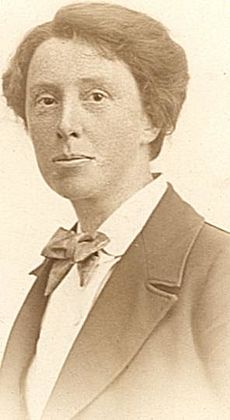Celia Wray facts for kids
Celia Wray (born May 30, 1872 – died November 30, 1954) was an English suffragette and an architect. A suffragette was a woman who actively campaigned for the right to vote in public elections. For many years, she was a close companion and fellow activist with the scientist Alice Laura Embleton.
Contents
Early Life
Celia Wray was born as Cecilia Wray in Barnsley, Yorkshire, in 1872. Her father, Charles Wray, was a pork butcher. He was also an important person in Barnsley. He served as the Mayor of Barnsley twice, from 1896 to 1897 and again from 1903 to 1904. He was a Liberal councillor and later an alderman. This meant he helped make decisions for the town. Charles Wray was known for his business and for supporting local community groups.
Fighting for Women's Rights
Architect and Suffragist
For a time, Celia Wray worked as an architect in Barnsley. In 1908, she designed some cottages in Cudworth that are still standing today.
Around 1896, she became a supporter of the Women's Emancipation Union. This group worked to improve women's rights. Celia Wray was also a very active campaigner for women's suffrage. This was the movement to get women the right to vote. She was a key member of the Barnsley Women's Suffrage Society, which started in 1902. She served as its Secretary from 1908 until 1920.
Working with Friends
Celia Wray had a close friendship with cancer scientist Alice Laura Embleton (1876–1960). They were both active in the suffrage movement. In January 1910, they were photographed with other suffragettes. They were protesting outside the offices of the Barnsley Chronicle newspaper.
In 1911, Celia Wray was living with her father in Barnsley. Alice Embleton was visiting her on the day of the 1911 census. Like many other suffragettes, both women marked their census paper. They wrote the message "Getting votes for those who pay the piper. Getting votes for women" across it. This was a way to protest that women who paid taxes could not vote.
Celia Wray, Alice Embleton, Evelina Haverfield, and Vera Holme formed a private group called the 'Foosack League'. This group was only for women and suffragists. They were very close friends, and many letters show their strong bond, especially during World War I.
Later Life and Legacy
In her later years, Celia Wray lived with Alice Embleton at a place called The Elms in Saxmundham, Suffolk. Celia Wray passed away in Blythburgh, Suffolk, in 1954. She was 82 years old.
See also
 In Spanish: Celia Wray para niños
In Spanish: Celia Wray para niños



